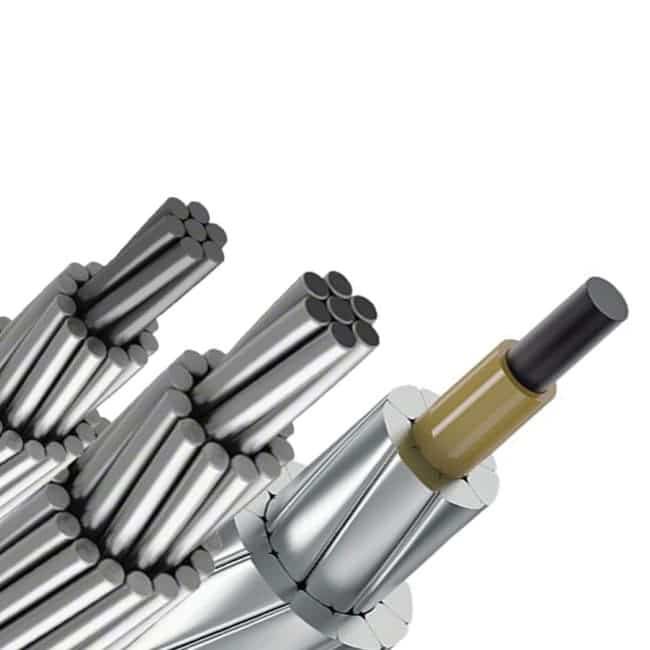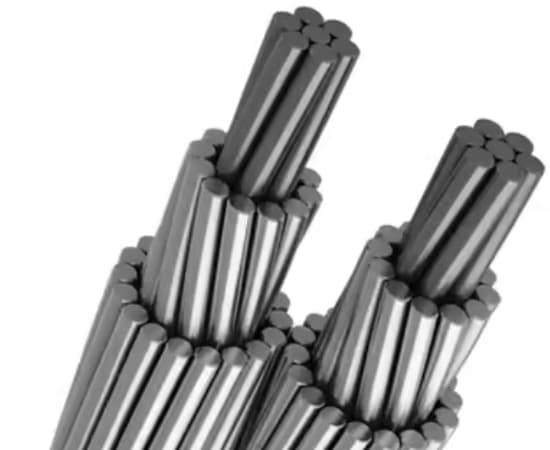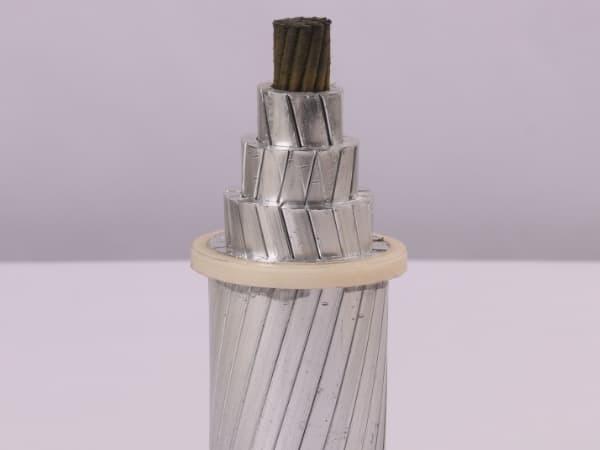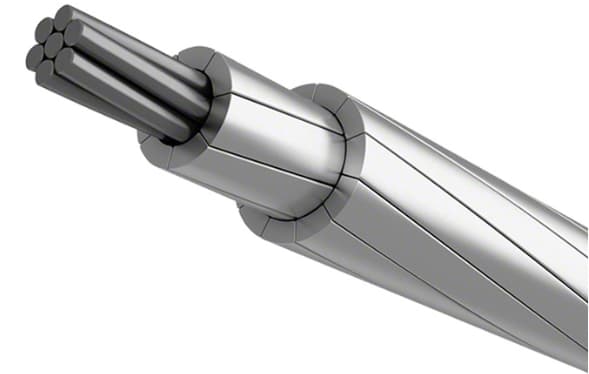
전력 송배전 분야, 도체는 효율적이고 안정적인 전력 전송을 보장하는 데 중요한 역할을 합니다.. 다양한 종류의 도체 중에서, 고온 저 변형 도체 (HTLS 지휘자) 및 알루미늄 강철 강화 도체 (ACSR 지휘자) 가장 눈에 띄는 옵션 중 두 가지는. 각 유형에는 고유한 특성이 있습니다., 장점과 응용, 따라서 둘 사이의 차이점을 이해하는 것이 중요합니다.. 이 기사에서는 HTLS 도체와 ACSR 도체를 포괄적으로 비교합니다., 그들의 재료를 탐구하다, 설계, 성능, 응용 프로그램 및 경제적 고려 사항.
소개
전기 도체는 모든 전력 전송 시스템의 중추입니다., 발전원에서 소비자에게 전기를 운송하는 것. 전력 수요가 늘어나면서, 보다 효율적이고 고용량 전송선에 대한 필요성이 점점 더 중요해지고 있습니다.. HTLS 및 ACSR 도체는 이러한 과제를 해결하기 위해 발전한 두 가지 기술입니다., 다양한 시나리오에 대한 다양한 솔루션 제공.
재료와 디자인
HTLS 지휘자
HTLS 도체 장력 하에서 낮은 처짐을 유지하면서 더 높은 온도를 견딜 수 있도록 특별히 설계되었습니다.. 이 독특한 성능은 고급 소재와 혁신적인 디자인을 통해 달성됩니다. HTLS 도체의 코어는 일반적으로 고강도, 탄소섬유나 특수금속합금 등 내열성 소재. 이 코어 소재는 인장 상태에서 도체를 지지하는 동시에 열팽창에도 저항하는 데 필요한 기계적 강도를 갖추고 있습니다..
HTLS 도체의 외부층은 고온에서도 전기 전도성과 강도를 유지하도록 특별히 설계된 특수 알루미늄 합금으로 구성됩니다.. 이 합금은 종종 다음과 같이 불립니다. “고온 알루미늄” 또는 “내열성 알루미늄”. 이러한 재료를 결합하면 도체가 지지 구조의 늘어짐이나 장력을 눈에 띄게 증가시키지 않고 기존 도체보다 훨씬 높은 온도에서 안전하게 작동할 수 있습니다..
ACSR 지휘자
ACSR 도체는 수십 년 동안 전송 산업의 중심이 되어 왔습니다.. 디자인이 비교적 단순합니다., 중앙 강철 코어와 하나 이상의 알루미늄 도체 층으로 구성. 강철 코어는 도체를 지지하는 데 필요한 기계적 강도를 제공합니다., 알루미늄이 전기를 전도하는 동안.
ACSR 도체에 사용되는 알루미늄은 가볍고 전도성이 뛰어납니다., 동력 전달에 이상적입니다.. 반면에, 강철 코어는 강하고 부식에 강합니다., 도체의 장기적인 무결성 보장.

성능 특성
온도 저항
HTLS와 ACSR 도체의 가장 중요한 차이점은 온도 저항입니다.; HTLS 도체는 과도한 처짐이나 장력 없이 ACSR 도체보다 훨씬 높은 온도에서 작동할 수 있습니다.. 이 기능은 주변 온도가 높은 지역이나 지원 인프라를 업그레이드하지 않고 기존 라인 용량을 늘려야 하는 지역에서 매우 중요합니다..
처짐과 긴장
용어 “낮은 경우” HTLS 도체에서 도체가 다양한 온도에서 상대적으로 일정한 처짐을 유지하는 능력을 나타냅니다.. 기온이 상승함에 따라, 기존 도체는 팽창하고 처지는 경향이 있습니다., 이는 지지 구조의 장력을 증가시킵니다.. 이로 인해 구조적 오류가 발생하거나 값비싼 업그레이드가 필요할 수 있습니다.. HTLS 도체, 반면에, 고급 소재와 디자인 덕분에 눈에 띄는 처짐이나 장력 변화 없이 더 높은 온도를 견딜 수 있습니다..
HTLS 도체는 심각한 처짐 없이 더 높은 온도에서 작동하도록 특별히 설계되었습니다., 전송 용량 증가 및 시스템 효율성 향상. 용어 “낮은 경우” 열팽창 하에서 상대적으로 안정적인 모양과 위치를 유지하는 도체의 능력을 나타냅니다., 이는 처짐이 라인 클리어런스 및 안전성에 큰 영향을 미칠 수 있는 장거리 송전선에서 특히 중요합니다..
대조적으로, ACSR 도체는 온도 변화에 대한 처짐 및 인장 반응이 더욱 두드러집니다.. 이러한 도체는 설계 범위 내에서 여전히 전력을 효율적으로 전달할 수 있지만, 증가된 부하 또는 온도에 대처하기 위해 추가 지지 구조 또는 업그레이드가 필요할 수 있습니다..
전기적 및 기계적 특성
HTLS 및 ACSR 도체 모두 우수한 전기적 및 기계적 특성을 가지고 있습니다.. HTLS 도체는 고온에서도 전기 전도성과 강도를 유지합니다., 안정적인 전력 전송 보장. ACSR 도체는 고온에 강하지 않지만 여전히 높은 전기 전도성과 기계적 강도를 가지고 있습니다., 다양한 응용 분야에서 신뢰할 수 있는 선택이 됩니다..

응용
HTLS 및 ACSR 도체의 선택은 주로 전송 시스템의 특정 요구 사항에 따라 달라집니다..
HTLS 도체 애플리케이션
HTLS 도체는 고온 또는 증가된 전송 용량이 필요한 응용 분야에 특히 적합합니다.. 예를 들어, 주변 온도가 지속적으로 높은 열대 또는 사막 지역, HTLS 도체는 과도한 처짐이나 장력 조정 없이 안정적인 전송 용량을 유지할 수 있습니다..
HTLS 도체는 새로운 타워나 통행권 침해 없이 전송 용량을 늘리기 위해 기존 전송선을 업그레이드하는 데에도 사용할 수 있습니다.. 기존 도체를 HTLS 도체로 교체하여, 유틸리티는 환경 및 지역 사회에 미치는 영향을 최소화하면서 회선의 전송 용량을 늘릴 수 있습니다..
ACSR 와이어 애플리케이션
ACSR 도체는 다양한 전송 및 배전 애플리케이션을 위한 첫 번째 선택입니다.. 다용성과 비용 효율성으로 인해 소규모 배전선부터 대규모 송전망에 이르기까지 모든 것에 이상적입니다..
HTLS 도체와 ACSR 도체의 주요 차이점은 디자인입니다., 재료 구성, 온도 등급, 처짐 특성, 무거운 전기 부하에서의 성능.HTLS 도체는 더 높은 온도 내성의 이점을 제공합니다., 처짐을 낮추다, 더 높은 전력 전달 능력, 그리고 더 가벼운 무게, ACSR 도체는 기계적 강도로 잘 알려져 있습니다., 신뢰할 수 있음, 및 비용 효율성. HTLS 및 ACSR 도체 선택은 특정 프로젝트 요구 사항에 따라 다릅니다., 환경 조건을 포함한, 전력 전달 요구, 예산 고려 사항. HTLS와 ACSR 도체 사이의 선택은 특정 프로젝트 요구 사항에 따라 다릅니다., 환경 조건을 포함한, 동력 전달 요구, 예산 고려 사항.

